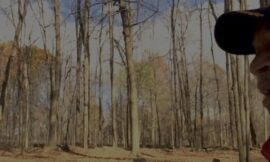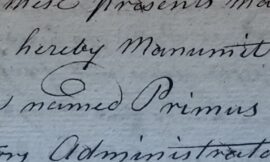For everyone
Washington & Lafayette in Dutchess County
Posted in: Countywide, Decoding Dutchess Past, For everyone

Black Burial Grounds: Dutchess
In Dutchess County, burial of Persons of Color took place in separate, segregated cemeteries into the early 20th century. The last known such burial was Lemuel Jackson of Red Hook, buried in the Turkey Hill “Colored Cemetery” in the Town of Milan in 1927. In addition to segregated cemeteries, there were segregated sections of larger cemeteries, often disallowing permanent markers. There were homestead or farm burials, as was the tradition especially prior to the Civil War. There were some, but few instances where highly regarded servants were buried in a predominantly White cemetery.
Posted in: African Heritage, For everyone
Education & Learning Center
The Dutchess County Historical Society is exploring new ways to support educators and students interested in developing critical thinking skills through the lens of local history. We welcome your suggestions. Learning Exercises How do changes in the US Constitution affect the lives of Persons of Color across generations? Name names. Specifically designed to to be taken as a tour either literally, or virtually, this is a self-guided tour that looks at some of the locations and people who have argued for the advancement of equality. Why might the local Pine Plains Register have eventually come to support the war with Spain? How might starkly different reporting on the same event by different newspapers affected the mindset and motivation of the young Pine Plains man who enlisted in the war? After reading the speech Susan B. Anthony gave locally, sum up her proposition to the local listeners in a few sentences. Describe how nationally known suffrage leaders came in contact with locals in the rural community of Red Hook, NY. Who would be motivated to vote yes (or no), and why? Compare and contrast the opinions of each of the two Bolins. Why might the issue come up at a time of war? Separated by a generation, Attorney Gaius Bolin speaks about race in 1919 at the end of World War One. Daughter Judge Jane Bolin speaks about race in 1944 at the height of World War Two. Print-out Coloring Book for Young Children by Joyce Ghee
Posted in: For everyone
Walter Patrice Collection
Posted in: African Heritage, DCHS Collections & Archives, For everyone, Poughkeepsie
Masonic Poughkeepsie
This Page is in Draft Form / Under Construction Freemasonry is the world’s first and largest fraternal organization. Poughkeepsie has had two Masonic Lodges. Since the 18th century locally, Masons have been men of achievement and influence. The first Lodge was Solomon’s Lodge No. 1, but the anti-masonic political movement in the 1820s ensured its demise. A second Lodge, No. 266, was created in 1852. DCHS is fortunate to have the responsibility to archive and preserve important early documents, as well as items from a number of collections where individuals were Masons. This 1780 certificate for Major Nicholas Fish shows the extraordinary pedigrees of the men involved in Solomon’s Lodge No. 1 at the time. Fish is the ancestor to the generations of public servants named Hamilton Fish, and the document is signed by Capt. James Livingston, Capt. Abraham Swartwout, and Andrew Billings. DCHS Collections. February 22 is not only the anniversary of the birth of George Washington, but the anniversary of the opening of the Masonic Temple on Poughkeepsie’s Cannon Street in 1895. DCHS Collections. Among the souvenirs from that event is a medal commemorating an important visit of George Washington to Poughkeepsie, who was an active Mason. On December 27, 1782, Washington was formally received at the home of Lewis Dubois, who was Grand Master of the Poughkeepsie Masonic Lodge. His home was located on Market Street just north of where the Bardavon is today, and was used for Masonic meetings. The man responsible for the design and gift of the coin to the Masons, Helmus Barratt, was born October 25, 1846 in DCHS’s home, Clinton House on Main Street. He was a founder and life-long Director of the First National Bank and an active Mason and patriotic American. A Methodist Episcopal Church was built on Cannon Street in 1854. On February 22, 1895, opening ceremonies revealed an enlarged and remodeled building as the new Masonic Temple, keeping the columns and general appearance of the front. DCHS Collections. Master Mason certificate from Lodge 226, successor to Solomon’s Lodge, dated November 28, 1860 for Joseph Wright. Wright operated a successful dry goods store on Main Street for many years and was perhaps best known as the Colonel of the 400-strong Twenty-first Regiment which was based locally. Above: Master Mason certificate from Lodge 226, successor to Solomon’s Lodge, dated November 28, 1860 for Joseph Wright. Wright operated a successful dry goods store on Main Street for many years and was perhaps best known as the Colonel of the 400-strong Twenty-first Regiment which was based locally. DCHS Collections. Click below right for full screen view of 1968 history of Lodge No. 266 by George Ress. Above: Jewel presented in 1851 “as a token of respect” to A. M. Sweet, first master of the newly created Lodge No. 266. DCHS Collections. We are continuing to build a permanent, online exhibition about local Masons, please check back over time, or email us with suggestions. ~ Bill Jeffway
Posted in: For everyone, Poughkeepsie

DCHS Collections: Documents of Enslavement
Powerful Personal Stories Focusing on numbers can divert our attention away from the personal, powerful stories of endurance and achievement. These items from DCHS Collections reveal how the legal system imposed a legal definition on men, women and children declaring them as legal property.
Posted in: African Heritage, For everyone

Annual Awards
Each year the Dutchess County Historical Society offers awards that recognize and encourage best practices in local history. The Helen Wilkinson Reynolds Award goes to an individual who has demonstrated a commitment to the “necessary and accurate pursuit of historical truth.” The Dutchess Award is given for “exceptional contributions in preservation, history & education.” The Business of Historic Distinction Award is given for longstanding tradition of service & commitment to Dutchess County residents. Eileen Mylod Hayden Award for teachers who impart a love of local history on students. Click on any image to learn more.
Posted in: DHCS Events, For everyone

Bain House Poughkeepsie
Kimberlee Breden of Poughkeepsie was not sure what to expect when she found a letter in her mailbox in November with a return address of New York State Governor Kathy Hochul and Erik Kulleseid, the Commissioner of the New York State Office of Parks, Recreation and Historic Preservation. The letter advised Breden that she was a recipient of the 2022 New York State Historic Preservation Award for Excellence in Historic Building Rehabilitation. The recognition was for the work she had done restoring her home at 57 Montgomery Street, Poughkeepsie, just east of the historic Memorial Fountain and Eastman Park. Referring to the house as the “F. R. Bain house,” the name of its original owner in 1888, the letter went on to say, “Your diligent efforts to restore your historic Victorian home exemplify the power of harnessing the Historic Homeownership Rehabilitation Credit and the finished product is an inspiring example in the City of Poughkeepsie. The delight is in the details and your work is bound to get other homeowners thinking about potential projects for their historic buildings.” Breden attended a ceremony in Albany in December, being one of ten award recipients. Let’s examine what makes this particular “adaptive re-use” particularly noteworthy. Bain House, 57 Montgomery Street, Poughkeepsie.Left to right: 1891, 2018 and 2022. Some owners of historic homes worry that designations and recognition can limit what they can do for their home, or that they might lose control of certain decisions. But Breden feels that the entire process has enabled her to have exactly the home she had dreamed of owning and living in. Such a project takes a combination of vision, and a deep commitment to ensuring that those qualities that can only come from historic homes are made a priority, and persistence in the face of obstacles. Breden feels that the financial incentives through tax credits took a good deal of careful navigation but made the difference in allowing her to restore the home to the degree that she did. Doing a good deal of work herself, “and returning bottles to get the five-cent deposit” all added up to making the project economically feasible. Where did this depth of commitment come from for Breden? It started early. “My earliest memories relate to my father’s grandparents who were from Germany. They owned a delicatessen in Mount Vernon in a beautiful old Victorian house. It was a couple stories. The retail was on the ground floor and they lived above. It had pocket doors, a club foot bathtub like my third floor has, it had a beautiful mahogany staircase and wainscoting. I was a little girl and I remember, I remember the way it smelled, everything.” Breden thinks this was one of the reasons that when she first saw 57 Montgomery Street in 2007, in spite of its state of disrepair, “it felt like home.” Attempts to purchase the house in 2007 and 2008 were not successful. That’s where serendipity, or the sense that “this was meant to be” comes into play. At 1:30 in the morning on September 23, 2009, something prompted Breden to do an online search for the property, wondering what had become of it. To her great surprise, she found that the house was being auctioned just a few hours later at 9:00 am. Breden made sure she was at the auction, and although it became a protracted process, she succeeded in securing the property from the bid she made that morning She moved into the house in 2010. Above all, Breden credits her father’s wisdom for the depth of commitment she has to the house, explaining, “My father would say he had three things that he stood by. He said, ‘You do the right thing because it is the right thing to do. You only do a job you would be proud to put your name on. And you leave a place better than when you found it.’ And that’s exactly what I feel about here.” The project has dimensions that involve scale, “I needed 1,177 shingles that were six inches wide, with a curved bottom,” Breden said. “I made 1,200 of them.” Equally, the project has dimensions that involve great detail. Breden says she is able to restore a third floor window’s colored glass with original colors because of the shards of broken glass she discovered buried in the backyard. Breden also credits great partnership, in particular Poughkeepsie Design Historian, Holly Wahlberg. And Toni Mauro, a member of the City of Poughkeepsie Historic District and Landmarks Preservation Commission at the time of Breden’s application for City, then State and National designation. Having secured City historic designation, in March of 2015 Wahlberg wrote a 21-page statement of significance in support of the application for both State and National historic designation, both of which were successful in 2016. Wahlberg explains the importance of the statement of significance saying, “Saving vulnerable houses requires a mixture of passion, knowledge and fearless determination. But the process begins with extensive research and writing. A National Register nomination must articulate not just the history of a house, but also what that history reveals about our nation and ourselves.”
Posted in: Decoding Dutchess Past, For everyone, Poughkeepsie
